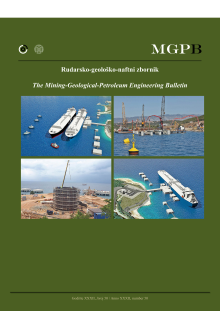Investigating the acoustic signs of different rock types based on the values of acoustic signal RMS
DOI:
https://doi.org/10.17794/rgn.2020.3.3Keywords:
Acoustic Emission Techniques (AET), Rock Type Recognition, Acoustic signals, Signals RMS, Drilling operationAbstract
Recent years have seen a vast increase in the use of acoustic waves in real-time and non-destructive detection and monitoring applications in various industries such as mining. Acoustic signal processing methods can provide accurate and reliable estimates of the condition of a process or material in a highly cost-effective way without interrupting the ongoing operations. This paper investigated whether the class of a rock and its strength properties can be estimated based solely on acoustic signals captured during the drilling operation. For this purpose, uniaxial compressive strength (UCS), Brazilian tensile strength (BTS), Schmidt rebound number (SRN), and longitudinal wave velocity (Pw) of a series of samples of sedimentary, metamorphic and igneous rocks were measured in a rock mechanics laboratory. The samples were then subjected to a drilling test and the acoustic signal propagating in the drilling medium was recorded by an acoustic sensor. After obtaining the time spectrum of the captured signals, their RMS values were calculated and compared with the mechanical properties of the corresponding rock samples. For the rocks tested in this study, the obtained RMS values were in the range of 800 to 1,600 and generally increased with the increase of strength and hardness. The RMS values obtained for each class of rocks had their own specific range. For sedimentary rocks, this range was 800 to 1000, for metamorphic rocks, it was 1000 to 1200, and for igneous rocks, it was 1400 to 1600. Given the differences in the range of RMS values obtained from the acoustic signals of drilling, these values can be used in the estimation of rock class and strength properties. These results show that there is significant potential for the future use of this approach in the industry for field identification and classification of rocks, especially in deep drilling operations or when there is little information about the characteristics of the rock being drilled.
Downloads
Published
How to Cite
Issue
Section
License
Copyright (c) 2020 authors and journal

This work is licensed under a Creative Commons Attribution 4.0 International License.
Creative Commons-BY
Authors who publish with this journal agree to the following terms:
In agreeing this form, you certify that:
- You read the ethical codex of the RGN zbornik available at journal web.
- You submitted work is your original work, and has not previously been published and does not include any form of plagiarism.
- You own copyright in the submitted work, and are therefore permitted to assign the licence to publish to RGN zbornik.
- Your submitted work contains no violation of any existing copyright or other third party right or any material of an obscene, libellous or otherwise unlawful nature.
- You have obtained permission for and acknowledged the source of any illustrations, diagrams or other material included in the work of which you are not the copyright owner.
- You have taken due care to ensure the accuracy of the work, and that, to the best of your knowledge, there are no false statements made within it.
- All co-authors of this submitted work are aware of, and in agreement with, the terms of this licence and that the submitted manuscript has been approved by these authors.
Publication licence
You retain copyright in your submitted work, according to journal license policy (CC-BY). By signing this form you agree that RGN zbornik may publish it under the publication licence. In summary the licence allows the following:
Anyone is free:
- To copy, distribute, display, and perform the work.
- To make derivative works.
Under the following conditions:
- The original author must always be given credit.
- The work may not be used for commercial purposes.
- If the work is altered, transformed, or built upon, the resulting work may only be distributed under a licence identical to this one.
Exceptions to the licence
In addition to publishing the work printed under the above licence, RGN zbornik will also enable the work to be visible online.
The journal editorial can change the licence rules anytime but it cannot retroactively restrict author(s) rights.


